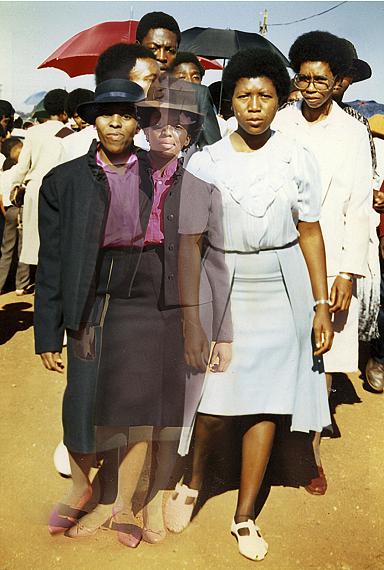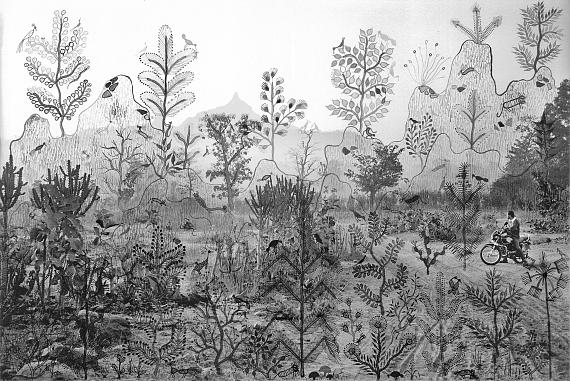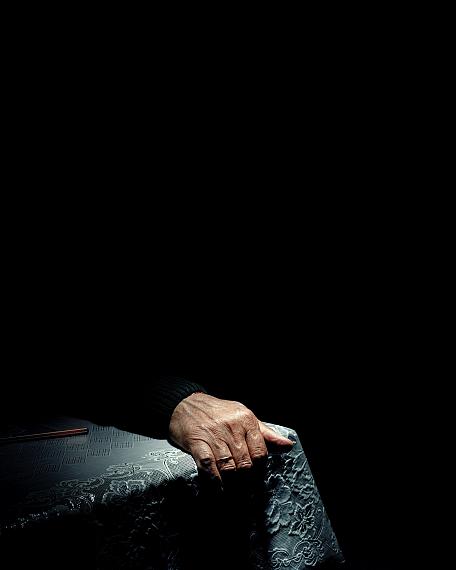
Re shapa setepe sa lenyalo II, 2013
© Lebohang Kganye
Deutsche Börse Photography Foundation Prize 2024
shortlist
VALIE EXPORT » Gauri Gill » Lebohang Kganye » Hrair Sarkissian »
Award:
Wed 1 Nov

Deutsche Börse Photography Foundation
Mergenthalerallee 61
65760 Eschborn
+49 (0)69-21 11 40 60
foundation@deutsche-boerse.com
deutscheboersephotographyfoundation.org/
by app. only

The Birth Madonna
after: Michelangelo Buonarroti, Pietà, Madonna della Febre, 1498-1501
Body position: reenactment
C-Print © VALIE EXPORT, Bildrecht Wien, 2023
Deutsche Börse Photography Foundation Prize
2024 shortlist
VALIE EXPORT, Gauri Gill & Rajesh Vangad, Lebohang Kganye und Hrair Sarkissian
This long-standing annual Prize, originally established in 1996 by the Photographers' Gallery in London, identifies and rewards artists for their projects that have made a significant contribution to photography over the previous 12 months.
Over its 27-year history, the Prize has become renowned as one of the most important international awards for photographers, spotlighting outstanding, innovative and thought-provoking work. The 2024 shortlisted projects all critically engage with urgent concerns, from the remnants of war and conflict, experiences of diasporic communities and decolonisation, to contested land, heritage, equality and gender. Together these artists demonstrate photography's unique capacity to reveal what is invisible, forgotten or marginalised and imagine a path to redress.
The annual exhibition of shortlisted projects will be on show at The Photographers' Gallery, London from 23 February to 2 June 2024. It will then be on display from 15 June to 15 September 2024 at the Deutsche Börse Photography Foundation in Eschborn/Frankfurt.
The winner of the £30,000 prize will be announced at an award ceremony held at The Photographers' Gallery on 16 May 2024, with the other finalists each receiving £5,000. Full details of the Prize exhibition and award evening will be announced in early 2024.
VALIE EXPORT (b. 1940, Austria) became notorious from the late 1960s for her radical performances and critical examination of women’s role in society and the arts. Pointing out entrenched patriarchal structures in mass media image culture, her fearless artistic practice exposes the role representation plays in the construction of gender, sexuality and social norms.
Through photographs, filmic works and installations, EXPORT deals with key issues including the body and the gaze, performance and the image, and subject and environment. Photography has played a pivotal role in her work, from documentation to multimedia installations and single works. EXPORT also often staged performances for the camera, with the intention of deconstructing the photographic gaze and its implicit power structures.
For over 50 years, VALIE EXPORT has influenced generations of female artists. In ground-breaking works such as "Aktionshose: Genitalpanik" ("Action Pants: Genital Panic", 1969), "TAPP und TASTKINO" ("TOUCH CINEMA", 1968) and "Hyperbulie" ("Hyperbulia", 1973), EXPORT contorts, cuts and deforms her body to expose the profound social oppression of women – a theme that continues to resonate today.
Through fusing photography and Warli painting, photographer Gauri Gill (b. 1970, India) and painter Rajesh Vangad (b. 1975, India) collaboratively reinvent the practice of painted photography, interweaving historical and generational painting practices into the photographic object. Their complex image dialogue addresses the politics of aesthetics, environmental destruction, memory and decolonisation.
The project began in 2013 in the Adivasi village of Ganjad, Dahanu. Vangad, who grew up in this landscape, served as Gill’s knowledgeable guide. While Gill’s photographs captured the ever-changing qualities of the land, they fell short of revealing the hidden but essential elements beyond the visible. Vangad bridged this gap by embellishing Gill's images with intricate drawings. His vivid narratives depict the multifaceted realities of Warli life in the region, from floods and droughts to family and village life, unrest and terror, spirits and myths, light and shadow. The result is a new visual record that encapsulates multiple truths and systems of knowledge.
In this encyclopaedic publication, the artists challenge contemporary perspectives. They explore how viewers ascribe meaning to a place and how the act of viewing itself creates complicity. Through their creative and experimental partnership, they encourage viewers to explore the hidden, elusive layers that exist beneath the surface.
Lebohang Kganye’s (b. 1990, South Africa) photographic projects cross personal and collective histories. She draws from shared oral narratives and fictional texts, exploring South Africa’s layered history before, during and after apartheid and colonialism.
In her vast, experimental installations, Kganye creates a space that resides between memory and fantasy. Here she collects stories from her family with excerpts from South African literature, and rewrites them into theatrical scripts. Silhouettes, cut-outs, puppets, shadows and ghosts, fashioned from material found in photo albums as well as her own compositions, (re-)enact these scripts and bring them to life. The exhibition features four projects which use a complex array of media – from photographic montages in "Ke Lefa Laka: Her-Story" ("It’s my inheritance: Her-Story", 2013) to spatial installation in "Mohlokomediwa Tora" ("Lighthouse Keeper", 2018), and film animation in "Shadows of Re-Memory" (2021) to patchwork in "Mosebetsi wa Dirithi" ("The Work of Shadows", 2022).
The exhibition's title, "Haufi nyana?" meaning "too close?" in Sesotho, one of South Africa's official languages, reflects the dialogue between the viewer and the artist. It touches on notions of home as heritage and identity, as well as physical and mental spaces. Her skilful blending of images and words allows her to navigate the complexity of the South African experience, opening new ways of understanding and contributing to the process of decolonisation.
Hrair Sarkissian’s (b. 1973, Syria) conceptual photography focuses on deeply personal narratives that reflect the complexity of larger historical and social issues. In "The Other Side of Silence", ostensibly serene landscapes and calm urban environments become stages for accounts of trauma and the expression of underlying socio-political realities. Born and raised in Syria, the grandson of Armenian genocide refugees, much of Sarkissian’s work can be seen as an exploration of the hidden emotional nuances that permeate the lives of diverse diasporic communities.
Sarkissian’s practice, characterised by his austere, large-scale photographs, moving image works, sculptures, sound works, and installations, oscillates between the creation of meditative dreamscapes and haunting deathscapes. In these spaces, the originally excluded muted voice is briefly offered room. Drawing from personal memories and interactions, and extensive research, Sarkissian aims to evoke emotional experiences among audiences, fostering awareness and a sense of solidarity.
This mid-career overview, spanning two decades, moves through the public squares of Aleppo, Latakia and Damascus, the skies of Palmyra over modern Syria and the post-industrial landscapes of Armenia. Despite employing analogue photographic practices, Sarkissian’s images play with the vernacular possibilities of photography as a mass medium, offering the opportunity to consider what official history conceals, and the potential for re-writing it.
The 2024 Jury: Rahaab Allana, Curator/Publisher, at Alkazi Foundation for the Arts, New Delhi, India; Quentin Bajac, Director of the Galerie Nationale du Jeu de Paume, Paris, France; Anne-Marie Beckmann, Director of the Deutsche Börse Photography Foundation, Frankfurt/Main, Germany; Laura El-Tantawy, documentary photographer; and Shoair Mavlian, Director of The Photographers’ Gallery, London, as voting Chair.

Mountains and Trees, 2014, from the series Fields of Sight, 2013-ongoing
© Gauri Gill and Rajesh Vangad
Deutsche Börse Photography Foundation Prize
Shortlist 2024
VALIE EXPORT, Gauri Gill & Rajesh Vangad, Lebohang Kganye und Hrair Sarkissian
Der einflussreiche Prize, der 1996 von der Photographers‘ Gallery in London ins Leben gerufen wurde, zeichnet jährlich Künstler*innen für ihre Projekte aus, die in den vergangenen 12 Monaten einen bedeutenden Beitrag zur Fotografie geleistet haben.
In seiner mittlerweile 27-jährigen Geschichte hat sich der Prize, der auf herausragende, innovative und zum Nachdenken anregende Positionen aufmerksam macht, zu einer der international renommiertesten Auszeichnungen für Fotograf*innen entwickelt. Die für den Deutsche Börse Photography Foundation Prize 2024 ausgewählten Projekte setzen sich kritisch mit drängenden Anliegen auseinander – von den Hinterlassenschaften von Krieg und Konflikt, über Erfahrungen von Diaspora- Gemeinschaften und Dekolonisierung bis hin zu Themen wie umkämpfter Heimat, Tradition und Erbe, Gleichheit und Geschlechterfragen. Mit ihren unterschiedlichen Projekten veranschaulichen die Künstler*innen die einzigartige Fähigkeit der Fotografie, Unsichtbares, Vergessenes oder Marginalisiertes ans Licht zu bringen und Wege der Wiedergutmachung zu entwerfen.
Die Ausstellung der ausgewählten Projekte wird vom 23. Februar bis zum 2. Juni 2024 in der Photographers’ Gallery, London zu sehen sein. Vom 15. Juni bis zum 15. September 2024 wird sie in der Deutsche Börse Photography Foundation in Frankfurt/Eschborn präsentiert.
Der*die Gewinner*in der Auszeichnung wird im Rahmen einer Preisverleihung am 16. Mai 2024 in der Photographers’ Gallery bekanntgegeben und erhält ein Preisgeld von 30.000 Britischen Pfund. Die anderen drei Finalist*innen erhalten jeweils 5.000 Britische Pfund. Einzelheiten zur Ausstellung und Preisverleihung werden Anfang 2024 bekanntgegeben.
VALIE EXPORT (*1940, Österreich) wurde in den späten 1960er Jahren für ihre radikalen Performances und ihre kritische Befragung der Rolle der Frau in der Gesellschaft und der Kunst bekannt. Mit ihrer unerschrockenen künstlerischen Praxis weist sie auf festgefahrene patriarchale Strukturen in der Bildkultur der Massenmedien hin und deckt so die Rolle auf, die die Darstellung in der Konstruktion von Geschlecht, Sexualität und gesellschaftlichen Normen spielt.
In Fotografien, filmischen Arbeiten und Installationen bearbeitet VALIE EXPORT Schlüsselthemen wie das Verhältnis von Körper und Blick, Performance und Bild, Subjekt und Umgebung. Die Fotografie – von der Dokumentation über multimediale Installationen und Einzelarbeiten – spielt eine zentrale Rolle in ihrem Werk. Um den fotografischen Blick und seine impliziten Machtstrukturen zu dekonstruieren, inszenierte VALIE EXPORT immer wieder auch Performances für die Kamera.
Seit über 50 Jahren hat VALIE EXPORT Generationen von Künstlerinnen geprägt. In bahnbrechenden Arbeiten wie "Aktionshose: Genitalpanik" (1969), "TAPP und TASTKINO 2" (1968) und "Hyperbulie" (1973) verrenkt, schneidet und deformiert sie ihren Körper, um die tiefgreifende soziale Unterdrückung von Frauen sichtbar zu machen – ein Thema, das bis heute von Bedeutung ist.
Durch das Verschmelzen von Fotografie und Warli-Malerei erfinden die Fotografin Gauri Gill (*1970, Indien) und der Maler Rajesh Vangad (*1975, Indien) gemeinsam die Praxis der bemalten Fotografie neu, indem sie historische und generationenübergreifende Malpraktiken in das fotografische Objekt einfügen. Ihr vielschichtiger Bild-Dialog beschäftigt sich mit der Politik der Ästhetik, mit Umweltzerstörung, Erinnerung und Dekolonisierung.
Das Projekt nahm 2013 in Ganjad, Dahanu, einem Adivasi-Dorf, seinen Anfang. Vangad, der in dieser Gegend aufgewachsen ist, diente Gill als kundiger Führer. Gills Fotografien fingen die sich ständig verändernden Eigenschaften der Landschaften ein, vermochten jedoch deren verborgene, aber dennoch wesentliche Aspekte, die über das Sichtbare hinausgehen, nicht zu enthüllen. Vangad schloss diese Lücke, indem er Gills Bilder mit kunstvollen Zeichnungen ausgestaltete. Seine anschaulichen Geschichten schildern die vielfältigen Realitäten des Warli-Lebens in der Region und erzählen von den Hochwassern und Dürren, dem Familien- und Dorfleben über Unruhen und Terror, Geister und Mythen, Licht und Schatten. Das Ergebnis ist eine neue Art der visuellen Aufzeichnung, die multiple Wahrheiten und Wissenssysteme zusammenfasst.
In dieser enzyklopädischen Publikation hinterfragen die Künstlerin und der Künstler vorherrschende Sichtweisen. Sie untersuchen, wie Betrachter*innen einem Ort eine Bedeutung zuschreiben und inwiefern bereits der Akt des Sehens eine Mittäterschaft generiert. Durch ihre kreative und experimentelle Partnerschaft ermuntern sie das Publikum dazu, die schwer fassbaren Schichten zu ergründen, die verborgen unter der Oberfläche existieren.
Die fotografischen Arbeiten von Lebohang Kganye (*1990, Südafrika) kombinieren persönliche und kollektive Geschichten miteinander. Um die vielschichtige Geschichte Südafrikas vor, während und nach Apartheid und Kolonialismus zu erforschen, greift sie auf mündlich weitergegebene Überlieferungen und literarische Texte zurück.
In ihren riesigen, experimentellen Installationen erschafft Kganye einen zwischen Erinnerung und Fantasie angesiedelten Raum. In diesem versammelt sie Geschichten aus ihrer eigenen Familie sowie Auszüge aus der südafrikanischen Literatur und schreibt sie zu Theaterdrehbüchern um. Silhouetten, Scherenschnitte, Marionetten, Schatten und Geister, die sie aus Materialfunden aus dem Fotoalbum sowie eigenen Kompositionen formt, (re-)inszenieren diese Storyboards und hauchen ihnen Leben ein. Die Ausstellung umfasst vier Arbeiten, die sich unterschiedlichste Medien zunutze machen – von fotografischen Montagen in "Ke Lefa Laka: Her-Story" ("It’s my inheritance: Her-Story“, 2013) bis zur Rauminstallation in "Mohlokomediwa Tora" ("Lighthouse Keeper", 2018), von der Filmanimation in "Shadows of Re-Memory" (2021) bis hin zum Patchwork in "Mosebetsi wa Dirithi" ("The Work of Shadows"", 2022).
Der in Sesotho, einer der offiziellen Sprachen Südafrikas, wiedergegebene Titel der Ausstellung "Haufi nyana?" – was soviel bedeutet wie "zu nah/zu eng?" – spiegelt den Dialog zwischen Betrachter*in und Künstlerin wider. Es geht um Vorstellungen von Heimat, Erbe und Identität, aber auch um physische und mentale Räume. Ihre geschickte Verschmelzung von Bildern und Worten erlaubt es Lebohang Kganye, die Vielschichtigkeit südafrikanischer Erfahrung zu durchdringen und dabei neue Verständniswege freizulegen, die zum Prozess der Dekolonisierung beitragen.
Die konzeptuelle Fotografie von Hrair Sarkissian (*1973, Syrien) widmet sich zutiefst persönlichen Geschichten, die zugleich die Komplexität größerer historischer und gesellschaftlicher Themen reflektieren. In "The Other Side of Silence" werden vordergründig heitere Landschaften und ruhige städtische Umgebungen zu Schauplätzen für die Darstellung von Traumata und den ihnen zugrundeliegenden soziopolitischen Realitäten. Das Werk von Hrair Sarkissian, der als Enkel von vor dem Völkermord geflüchteten Armenier*innen in Syrien geboren und aufgewachsen ist, kann als Auslotung der verborgenen emotionalen Zwischentöne verstanden werden, die die Lebenswirklichkeiten verschiedener Diaspora-Gemeinschaften durchdringen.
Seine künstlerische Praxis, die sich durch seine schlichten großformatigen Fotografien, Werke aus Bewegtbildern, Skulpturen, Soundarbeiten und Installationen auszeichnet, oszilliert zwischen der Erzeugung meditativer Traum- und beklemmender Todeslandschaften. In diesen Zwischenräumen wird der ursprünglich ausgeschlossenen, zum Schweigen gebrachten Stimme für einen Moment Raum gegeben. Im Rückgriff sowohl auf persönliche Erinnerungen und Beziehungen als auch auf umfangreiche Recherchearbeit, versucht Sarkissian, emotionale Erlebnisse beim Publikum heraufzubeschwören und das Bewusstsein und einen Sinn für Solidarität zu stärken.
Dieser Überblick über zwei Jahrzehnte seines Schaffens führt uns durch die öffentlichen Plätze von Aleppo, Latakia und Damaskus, die Himmel von Palmyra im modernen Syrien und die postindustriellen Landschaften Armeniens. Auch wenn er sich analoger fotografischer Verfahren bedient, spielen Hrair Sarkissians Bilder mit den ureigenen Möglichkeiten der Fotografie als Massenmedium. Sie bieten die Gelegenheit, darüber nachzudenken, was die offizielle Geschichte verdeckt, wie auch das Potenzial, diese Geschichte neu zu schreiben.
Die Jury 2024: Rahaab Allana, Kurator und Herausgeber, Alkazi Foundation for the Arts, New Delhi, Indien; Quentin Bajac, Direktor der Galerie Nationale du Jeu de Paume, Paris, Frankreich; Anne-Marie Beckmann, Direktorin der Deutsche Börse Photography Foundation, Frankfurt/Main, Deutschland; Laura El-Tantawy, Dokumentarfotografin; und Shoair Mavlian, Direktorin der Photographers’ Gallery, London, als stimmberechtigte Vorsitzende.

Unexposed, 2012
© Hrair Sarkissian